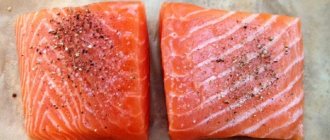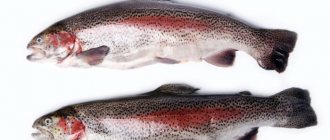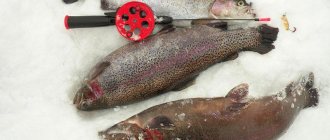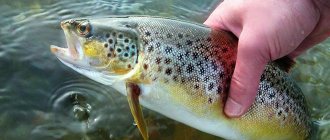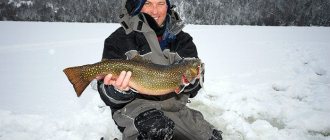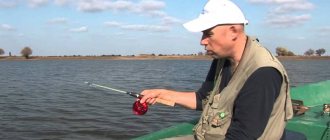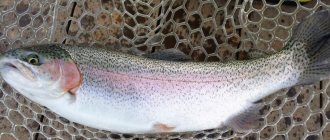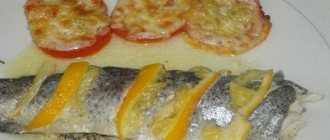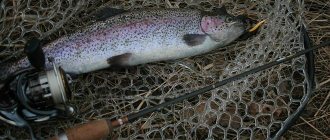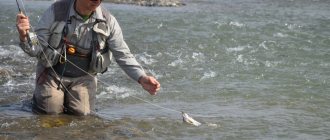Gennady Shelyag | October 8, 2021
Trout fishing in the mountain rivers of the Caucasus - whether float, spinning, fly fishing - has always been one of the most interesting and favorite for me. This fish itself is cunning, unpredictable, strong, fast and very careful. Trout fishing is about stalking, sneaking, and skillfully presenting the right bait. This is the joy of victories and the bitterness of defeats. It will make you forget about everything and plunge completely and completely into the mysterious aura of this noble hunt.
Where does Caucasian trout live?
On mountain rivers in the vicinity of Sochi, I mostly manage to fish in the lower reaches, but there is high fishing pressure there. And trout is present in abundance in the middle reaches and upper reaches, since it takes a long time to get to these places. Therefore, on most of my fishing trips, I focus on podust and barbel, as the most widespread representatives of the local ichthyofauna. I will definitely write about hunting for these wonderful fish in my next articles, but for now – about trout. You can also catch pied fish on these fishing trips, but specifically hunting only for them is ineffective. I repeat, this applies specifically to Sochi rivers.
As for the rivers of neighboring Abkhazia, the situation here is somewhat different. The sparse population of the republic contributed to the fact that these rivers remained practically wild, and Caucasian trout lives here everywhere - from the mouths to the upper reaches. I was recently lucky enough to visit several rivers near the capital of Abkhazia, the city of Sukhum. I was simply amazed by the abundance of water, beauty and wonderful originality of the local rivers. This is something that is truly worth seeing and is worth fishing for everyone.
Habitats and sites. Trout in the Caucasus
Trout is a fairly common fish in the Caucasus. I'll start with a description of the typical habitats of trout on Caucasian rivers. First of all, our attention should be drawn to the pits under waterfalls and rapids - these are the quietest and deepest places on fast mountain rivers.
Depending on the nature of the relief and the geological structure of the area, the pits are very diverse. Sometimes in a river, where you can jump over stones almost everywhere without getting your feet wet, and for which holes with a diameter of 3-5 m are common, a hole with a diameter of 10-15 m suddenly appears; a similar phenomenon is typical for the limestone strip of the southwestern periphery of the Caucasus Range . On large, by Caucasian standards, stormy rivers, the pits are correspondingly larger - up to 20-30 m wide and 30-35 m long.
You can also see the following picture: the cross-section of the riverbed is littered with huge boulders, and a violent stream breaking through between them creates a series of waterfalls up to three meters in height, and holes form under each one. Often the mirrors of these pits are at different levels, and water flows from one to another. In this way, on one cross section of the river there are 2-3 decent holes, fenced off from each other by large boulders. They are especially interesting to me because they are inaccessible to most anglers.
Often, at turns - sometimes from the right, sometimes from the left - the river crashes into the rocks. Deep longitudinal gullies form along them, and on the opposite bank there are pebble and gravel shallows. Such places are very interesting to fish with both a spoon and a wobbler.
to the spinning angler are also deep riffles with a smooth current, lulls behind large rocks, areas with reverse flow near tributaries and branches of the main river bed, whirlpools in the rubble and sediment of trees, breaker spits and deep corridors between rocks.
Fishing year after year in the same places, my friends and I came to the conclusion that in small pools, trout stick to strictly defined shelters, be it a boulder, a log, or a washed-out bank. And only in large holes does it change sites, depending on the time of day.
On mountain rivers, areas suitable for spinning are located at some distance from each other. Sometimes the distance between them can reach 500 meters, and believe me, this is a long distance on a mountain river - after all, there are no paths along it. In general, the banks of our trout rivers and streams are mostly difficult to pass. Dense thickets of trees, bushes and tall grass, steep, steep banks, rocks and boulders, as well as sometimes swampy floodplains make movement very difficult. During a hunt, a lot of time is spent moving from place to place and overcoming various kinds of natural obstacles. Therefore, good knowledge of places can help the fisherman rationally plan the time allotted for fishing.
Everyone must find their place themselves!
In this article I will deliberately not give the names of those rivers where I had productive fishing trips. Anyone who wants to find trout in the Caucasus, with the proper experience, will find their own river and their own promising area. There really are enough for everyone. If we add here the streams flowing into the rivers, each of which necessarily contains Caucasian pied, then there are an unusually large number of places for fishing. But why won't I be more specific?
There are several serious problems that have affected mountain rivers as well as many water bodies in the middle zone. I'm talking about barbaric poaching in the form of using an electric fishing rod. I’m also talking about the so-called underwater hunters, who have the conscience to dive into mountain micropits and shoot point-blank fish that have nowhere to go. I am also talking about those who are smart enough to fish with nets in small mountain rivers. The cynicism of individual “fishing enthusiasts” sometimes reaches its limit.
It is they who, when finding new places for their dirty fishing, use specific information, receiving it on fishing forums, in articles published in popular magazines.
Spinning with a Caucasian Accent
Trout in the Caucasus is the most desirable catch for a spinning fisherman.
Seething streams in mountain canyons, spilling over rock formations into dozens of small streams, and then reuniting into a single mighty stream, unexpectedly rushing off the rock like a resounding waterfall - the beauty of the Caucasus is unique, it is mesmerizing, but at first it is difficult for a resident of the plain to imagine fishing in such conditions. But this is where the trout live, and this is where they are caught. Brook trout is the most common aquatic predator in the mountainous regions of the Caucasus. Is it caught here with spoons and wobblers? After all, in the Caucasus, spinning was and still is not a very developed fishing method, which is due to the small number of predatory fish in the region’s waters and the lack of spinning traditions among fishermen. And is it even possible to cast a spinning bait normally in the foaming water of mountain rivers, with their inherent fast and powerful currents, in a channel blocked by many boulders ? I answer - perhaps, and even quite successfully.
Fishing tours in Georgia
Popular local type of fishing
But let's return to civilized trout fishing. First of all, I want to talk about the simplest, most catchy and most ancient form of trout fishing. I mean fishing with natural bait.
This method allows you to catch trout in situations where any other gear becomes ineffective. For example, in muddy water, which also has a gray-green-blue tint. Or when the water becomes the color of coffee with milk, and its level also rises significantly. Or there are also very small streams flowing in such thickets where it is almost impossible to cast a spinning bait or fly fishing fly.
In addition, the stream micro-holes where the pied fish usually stand are so small that you won’t even have half a meter to place the bait. Of course, spinners can try vertical lures. Fly fishermen should use vertical dipping, in which the “fly” is simply placed on the surface with a rod at arm’s length.
You can try all this, but you won’t be able to really successfully fish this way in most places. The approaches to many points are too difficult and the fly and spinning rods are too short. There may even be a need to creep up on your knees, squatting, and sometimes almost on your belly. For extreme sports fans and ardent supporters of only spinning or only fly fishing, this will be exactly what they need, but for the rest...
Best time for spinning fishing
The best time to hunt trout is early spring. At this time, you can catch many large specimens of this fish.
Also in spring, trout are not particularly wary; they can often be found in easily accessible places. Mostly this fish lives in small and shallow reservoirs.
And closer to the middle of the month, with the onset of warmth and the arrival of insects, you can safely set out to catch trophy specimens in absolutely any reservoir and regardless of their depth.
Experienced fishermen advise following the following rules, with the help of which you will always be guaranteed a catch:
- the bait must be kept in the current, without reeling in the fishing line, while slightly lowering it down; in this case you will have many chances of catching large fish;
- You should choose quiet places for fishing behind the rocks, because... trout are known to periodically take a break from the turbulent current.
Not everyone can catch trout in muddy water. In this case, it is better to take a fluorescent spoon and cast it as accurately as possible.
Often fish can also be seen in holes that are formed due to fallen trees. In this situation, you should take a wobbler. And when fishing for trout from the shore, you need to move exclusively upstream.
Once the fish has taken the hook, many inexperienced anglers are faced with another problem: how to pull the fish out. During this time, she will struggle to free herself, so you will need to be resilient and patient to complete the process successfully.
You can catch trout all year round, although in winter fishing is not so important, since it is extremely difficult to catch trout from the ice. In addition, it is obvious that spinning rods are not suitable for trout in winter.
- In the spring, after the snow and ice melt, it is difficult to catch trout due to muddy water and high water levels in the rivers. The increase in biting intensity is associated precisely with a decrease in the flood level in the reservoir, as well as with the emergence of insects that make up the trout’s food base.
- Summer is the time for the most varied trout fishing. During this period, she is very picky and will not take just any bait. Fish should be looked for in various shelters and at depth.
- Trout fishing is at its best in the fall. Before the coming winter, the fish fattens up, so its bite is intense and stable.
And here's what you need to know: All about fishing: Catching carp in the current
The greatest activity is observed in the morning; during the day the bite weakens somewhat, only to intensify again in the evening. At night, trout do not bite at all, so night fishing is not practiced.
On ponds and lakes it is possible to catch trout before sunrise. These cases are infrequent, but almost always yield a trophy specimen.
The device of a float trout fishing rod
To catch pied fish, local fishermen use fly rods. They choose a telescopic rod 4–5 m long that is very light, fast action, with a thin and sensitive tip. The main line with a diameter of 0.2 - 0.22 mm is cut to the length of the rod.
Blind float equipment does not contain anything special, but at the same time it does not allow for special arbitrariness. The float on this tackle is, rather, a bite indicator made from a piece of a match or a small twig attached to the fishing line using a cambric. This indicator is installed at a distance of 0.5 - 1 m from the sinker - depending on the depth at which it is fished.
A sliding sinker weighing 2 - 3 g - round or in the form of a thin cylinder. To connect the main fishing line and the leash, a microcarabiner measuring 1.5 - 3 mm is used. A leash with a thickness of 0.15 - 0.17 mm and a length of 20 - 30 cm, preferably fluorocarbon, hook No. 6 - 8 according to the Western European classification.
Trout fishing gear
Trout fishing is provided by a set of gear made from universal tools and materials available to the fisherman at each fishing retail outlet. Only when assembling fly fishing gear can some difficulties arise, requiring narrow specific knowledge regarding both the rods themselves and the composition of the cords. In further information, the angler will be presented with directions for choosing various gear for trout fishing, ensuring the catch of a predator in natural conditions and in the conditions of a paid pond.
Spinning
Trout fishing in the fall is most successful using spinning rods. The fish, starting to actively feed, becomes an energetic and sharp predator with aggressive behavior, sensitively responding to the placement of artificial baits in different water horizons. For fishing, spinning rods of semi-fast and fast action are selected. Ultralight tackle and tackle for supplying baits of 15–20 grams are optimal for catching predators according to their test characteristics. Since fishing can be done from boats and shorelines, spinning rod lengths vary from 1.7 to 2.3 meters when fishing from a floating craft, and for the shore, with the expectation of long-distance fishing, fishing rods with a length of 2.5 to 3.2 meters are used .
Lake trout fishing, like brook trout fishing, is universal in the selection of spinning equipment, which includes spinning reels with a high gear ratio and braided cords of small diameters, rarely exceeding a thickness of 0.15 mm. Wary fish require delicate rigs that are not overloaded with accessories in the form of ineffective leashes and bulky fasteners that make the rigs rougher and, therefore, less attractive to predators. Spinning fishing is done using wobblers, spinners and silicone baits. In some cases, it is rational to use live fry, fish fillets and pastes specially prepared for trout fishing.
Fly fishing
Trout fishing in mountain rivers and fast streams is the domain of fly fishing equipment. For fly fishing, a lightweight prefabricated fishing rod up to 2.5 meters long is equipped with an inertial reel with a reliable braking system. The volume of the reel should allow it to accommodate the main thick cord and its working part, which is selected depending on the fishing conditions and the use of the bait in a floating or sinking version.
It is difficult to catch trout in winter or autumn with fly fishing, since the fish goes to the bottom horizons, where they mainly feed, but at the end of spring and throughout the summer season, especially when the mayfly emerges, this type of hunting is considered the most promising. Fly fishing is done in a wade, so as additional equipment, the angler will need to purchase waders or a floating raft, which make fishing not only more comfortable, but also much more successful in terms of choosing promising points and camouflaging the angler himself.
Important! The main lures in fly fishing are artificial dry and wet flies.
Also quite often, and it is especially effective to do this after their flight, natural insects are used.
Float rod
An effective fishing method is a float rod, or rather, a Bolognese version of this type of tackle, equipped with an inertial reel with a large drum, which allows fishing with bait swims over long distances. Telescopic fishing rods 6-7 meters long are selected from the lightest materials, graphite or carbon fiber. For fishing, a braided cord with a thickness of 0.10-0.12 mm is used at the end with a meter-long nylon leash of 0.12-0.14 mm. Hooks for trout fishing are selected based on the type of bait. Most of the selected accessories have an elongated fore-end with hook numbers from 10 to 14.
Important! They are caught with float tackle in the spring months and throughout the entire autumn season, when the predator switches to feeding in the middle water horizons.
Plant and animal baits are used as bait. Under some conditions, the predator can also be caught using wet artificial flies.
Feeder
The feeder is not as popular as all the hunting methods described above, but its effectiveness deservedly needs to be discussed during the pre-winter period, when the predator goes to the deepest points of reservoirs, which is especially important for paid ponds. For fishing, rods with a length of 2.8 -3.5 meters are used, with test parameters no higher than 50 grams. Choosing the right bait with the ability to boil and create a distinct spot of turbidity attracts predators from afar, making fishing from the bottom quite successful. The rigs are knitted from monofilament, using nylon or transparent fluorocarbon leashes one meter long in the rig, equipping the hooks with animal baits or a bright and fragrant paste.
Whitebait is the best bait
The bait used is minnow fry and roach, which are present in large numbers in the lower reaches of rivers. You need to stock up on them before fishing right there, because in the upper reaches this is very problematic, and in most cases impossible due to the fast current.
Store the fry in cold water in a thermos or small container. At the same time, in order for the fry to remain active, the water in the container must be constantly changed, not allowing it to heat up. For fishing with whitebait, hooks with long and medium-length shanks are used. The fry is baited so as not to allow the current or fish to easily dislodge it from the hook, but at the same time trying to keep it alive as long as possible. If you are heading to the mountains for a few days, then the fry can be salted and used as bait in this form. This bait works worse, but it still works.
Trout fishing requires mobility and compactness
Of course, rivers have very cold water at any time of the year, so the use of waders is simply necessary. It is always necessary to choose thermal underwear for the comfort of fishing and movement very correctly. The staff won't hurt you at all when moving. Personally, I have been successfully using SIMMS wader equipment for many years, and it has never let me down. One of the main conditions for your fishing should be your mobility and your compactness. Nothing superfluous and at the same time everything you need should always be at your fingertips.
Worms and larvae
In addition to fry, earthworms and dungworms are collected for bait, which are stocked up in advance. If you run out of worms while fishing in the mountains, they can be found along river banks under rotten trunks, leaves and under stones lying on the ground. A worm is baited onto a black hook with a medium-sized shank so that most of the hook is hidden. The tails of the worm should hang down on both sides. Small worms can be baited in groups of two or three. In addition to worms, red caviar and insect larvae obtained from rotten stumps and tree trunks can be used as bait.
How to catch
The fishing technique for all types of natural baits includes precise casting, sinking the sinker to the bottom and retrieving the bait near the bottom, controlled using the rod tip. The same indicator on the fishing line helps you navigate by the depth of the wiring. The wiring is carried out so that the sinker touches the bottom from time to time.
The bite is felt by the rod, which is why it must be very sensitive. If the water in a river or stream is absolutely clear, the cast should be made upstream - so that the bait is carried towards you. This way you will remain invisible to the trout.
A spinning expert's story
The second method of trout fishing has the most followers in our country. This, as you may have guessed, is spinning fishing, and it is better to use baits aimed specifically at trout. Most recently, I had the opportunity to go fishing in Abkhazia with Alexander Gorodyankin, one of the best experts in trout fishing in local rivers. This man not only knows all the local rivers very well, not only is he fluent in the intricacies of spinning fishing, but he also taught this art to many people who rightfully consider him their teacher. I'll tell you briefly what he advised me.
Spinning rods with a cast weight of up to 20 g are suitable for trout fishing. The optimal length of spinning rods is from 1.8 to 2.5 m. Inertialess reels are suitable for sizes from 1000 to 2500 according to the Japanese classification. The thickness of the cord is recommended from 0.07 to 0.15 mm, monofilament line or fluorocarbon - from 0.18 to 0.22 mm.
All spinning trout lures are divided into such main categories as wobblers, “shakers”, “spinners” and “silicone”. But there are so many effectively working spinning models that it can amaze any fisherman. For me personally, Alexander said, one of the main indicators when choosing them is continuity and consistency. You just need to generalize your experience, select baits that have worked even once, and be interested in what your fellow hobbyists are fishing for.
Trout very often stand in places that are difficult to supply bait. To these I would include sections of the river under overhanging tree branches, near fallen trunks, under rocks. The accuracy of your casts and the absence of fear of losing your favorite wobbler on the hook are very important here. If you have both, your chances of successful fishing increase significantly. It is especially difficult to fish with a spinning rod in small streams, where a combination of caution, accuracy, realism of the bait and the jewelry of your retrieve is required. Each hole gives only one chance to do it correctly - mistakes are not forgiven to anyone.
Spinning rod for catching brook trout
When fishing for trout with a spinning rod, fishing a stream or river, casting bait, you must have good spinning fishing technique and be able to make accurate casts. In many places you have to cast the lure close to snags or branches, and here you need pinpoint precision in throwing the bait into the water, a few centimeters away from bushes or stones. You also often have to cast from under overhanging branches and from other inconvenient positions. The slightest inaccuracy usually leads to a hook that will be difficult to unhook without spooking the trout in the river.
For accurate casting, you need not only the ability to throw the lure to the desired point, but also a well-selected spinning rod in length, action and test, equipped with a high-quality reel with fishing line. To catch river trout with a spoon or wobbler, it is better to take a plug-in light or ultralight spinning rod with a Medium-Fast action or a Fast action. And it is better to take such a spinning rod with a length of 180-220 cm, with a test in the range of 0.5-8 grams, since on streams and rivers, trout baits are mainly used small and light, weighing 0.5-10 grams.
Of course, trout fishing professionals at competitions may have 4-6 spinning rods with different tests and structures. But when actively fishing for trout with a spinning rod on a river where there are many obstacles, bushes, trees and stones, it is better to have one more or less universal spinning rod and perhaps another spare one.
It may seem that a spinning rod with such a small dough looks thin, fragile and can easily break. But if handled correctly, it is impossible to break the spinning rod while fishing for fish; if you avoid sharp angles between the rod handle and the tensioned fishing line, then nothing bad will happen, again, if the fishing line is installed with a load limit for the given spinning rod.
On high-quality spinning rods, the rod blank indicates the maximum breaking load of the fishing line in libres (lb), the same thick fishing line that can be used on this spinning rod without damaging the rod. To determine the diameter of the fishing line, there are comparative tables of the correspondence of the load in units (lb) to the possible diameter of the fishing line in millimeters.
Fishing with an artificial fly
And finally, fly fishing - as the most difficult, beautiful and unpredictably exciting form of trout fishing. It is worth noting that Caucasian trout is a great original, because I could not tempt it with small “flies”. She would rather grab a “fly” that barely fits in her mouth. For trout fishing, rods from 0 to 4 classes with a length of 2.4 - 2.7 m are used.
Reels of the appropriate class should accommodate your line, leader and 150 m of backing. I highly recommend keeping this amount of backing on gear of any class, since the Black Sea sea trout, which enters mountain rivers, always falls for your bait at the most inopportune moment. And if you are ready to compete with a giant with light-class tackle, extra meters of backing will not hinder you at all.
Which rivers are suitable for us? Trout in the Caucasus.
Trout in the Caucasus
However, I will immediately note that in the mountain rivers of the Caucasus, not all trout sites are accessible for spinning fishing. Tackle, bait and spinning have nothing to do with it - the rivers simply have too fast flows and many hard-to-reach places. For example, the upper reaches of the Terek, Inguri, Rioni, Aragvi, our famous rivers that originate in the glaciers of the Main Caucasus Range (in particular, the Central Caucasus), are completely unsuitable for spinning : for many kilometers there is a continuous foamy rapids, and to make a full-fledged wiring a spinning bait is not possible.
It’s exactly the same in the North Caucasus: the rivers running down from the Side and Main ridges of the Central Caucasus are not very suitable for spinning baits, well, unless there are a few sections where the gorges widen and rivers flow on their flat bottom. But even there, due to the high water level and the content of a significant amount of suspended material, the fishing season is very limited: water clearing most often occurs from August - September, when night temperatures become lower and glaciers stop melting intensively.
Better for spinning anglers are the rivers descending from the Skalisty and Lesisty ridges - for example, Khaznidon, Psygansu, Lesken. And the most suitable rivers for spinning trout fishing in Georgia are located in the Samegrelo region. Their sources are not on the Main Caucasus Ridge, but on parallel, lower ridges. Glacial feeding here is not so pronounced, so the river water brightens much earlier after the spring flood. These rivers are so good that they provide excellent fly fishing.
Some deep rivers of the Lesser Caucasus in Imereti, Guria and Adjara, as well as part of the rivers of the volcanic highlands of Southern Georgia, are also suitable for spinning The latter are most suitable for those who like to hunt with a spinning rod , because... Seasonal fluctuations in water here are least pronounced, and a significant part of the diet comes from spring waters.
Cords, leaders and leashes
On Caucasian rivers, two types of floating lines can be used: with a short, weighted torpedo and with an elongated torpedo. The first type of line will help you cut through the wind and make long casts with light tackle. Soft presentation and splashdown of a dry “fly” when fishing for brook trout in most cases is not useful.
Cords of the second type will be indispensable when using spey casts. They will help you make casts where it would be impossible to cast from behind your head. You can, of course, have a set of sinking leaders with you when fishing, but in most cases it will not be useful. The leader material is from 0.12 to 0.18 mm, it is preferable to use fluorocarbon as it is less visible.
Fishing for trout with a fishing rod
Trout, which is released into lakes in Europe and Russia intended for sport fishing, is taken from fish farms, where it is accustomed to eating special food, unlike those fish that live in the natural environment. At first, such a trout does not suspect that anything has changed in its life. On the contrary, she is attracted to people and the noise of cars, reminiscent of the sound of a diesel engine throwing food to fish on farms.
Therefore, in such lakes you can find and catch two types of trout , different in behavior: the one that was released into the reservoir a long time ago, it is very careful towards people, artificial and natural baits offered to it by anglers, and the one that was released recently, it is in At first it’s easy to catch with almost any bait. However, this does not last long, and the behavior of freshly released trout soon changes, especially if the “newly arrived” fish are subject to strong fishing pressure and whole hordes of various baits pass before their eyes. The trout becomes distrustful and cautious, and it is now much more difficult to catch them.
She likes it cool
Fishing for lake trout in Italy begins in the fall, since at this time it rises from the depths to the upper layers of water, located far from the shore. During the period of “withering nature,” the leaves on the trees turn yellow and fall off, and the same thing happens in reservoirs. Aquatic vegetation begins to die off, and this process occurs annually. Dead plants decompose, which requires a large amount of oxygen dissolved in the water, and trout , experiencing a lack of it for their life activity (for bottom fish, such as carp and American catfish, there is no such problem), is forced to rise to the uppermost layers of water, where there is more oxygen (thanks to precipitation and wind, which creates ripples). At this time, the water temperature is slightly below 22°C (at temperatures above 22°C, trout die), the sun is still quite high and its angle interferes with the eyes of the trout, so it prefers darker areas of the reservoir. All this (low oxygen supply, high temperature + sun) causes the trout to gather in schools, behave apathetically, and we find them almost close to the surface of the water.
We start with spinners and wobblers for trout fishing
Or - why do river and lake trout bite?
At this time, artificial baits such as spinners No. 0-4 with a wide blade, for example the Comet type, are suitable for catching it, because they are more superficial, as well as Blue Fox Super Vibrax No. 1 and 3, Panter Martin No. 4, 6, Eh, Blue Fox Shallow Super Vibrax No. 2 and 3. Their weight is approximately 5-10 g. I myself prefer spinners from Italian companies; PercaTigere Fluo 5-8 g, Vampir 13 g, Aroito Ondula-to 8 g - they have a wide shape, therefore they are especially good for standing water and even with slow retrieve they stay near the surface. But wobblers of the SSR and SB categories are still best suited for this fishing period. My favorites are the Megabass Baby Griffon Zero 37.8mm; Megabass Baby Griffon X-Force 37.8 mm; ZipBaits Hickory SSR 34 mm; Pontoon21 Hipnose 38F SR; Smith Camion SR; Buzzn Crank OS.P.; Ever Green Crazy Cradle; Rat-a-Tat Hyper Sonik.
To retrieve such baits, I use a rather soft Black Hole Classic spinning rod 2.55 m long with 3-12 g of dough, since trout have a delicate mouth, and in order not to damage it, a softer rod is required, especially since the reel is wound with Sea braid Bass Hard 12 lb. Such a line test is justified, since large, strong individuals are often caught, for example, lake trout weighing over 5 kg. I myself once caught a fish that weighed 5.7 kg. A spinning rod longer than 2.4 m is recommended, because schools of trout are far from the shore during this period. On many lakes, the rules do not allow the use of treble hooks on artificial baits in order to reduce injury to the fish, but if you intend to fish on a catch-and-release basis, it is better, even if the rules do not require it. Use barbless single hooks. I prefer the latter, so I immediately remove the tees. Of course, fish catches happen more often, but the fish is less in the hands of the angler and less time is required to remove it from the hook.
If the result comes first, something “edible” is better.
Fishing for trout with spoons, wobblers, etc. practiced here infrequently, as most Italian anglers consider it less practical. I have rarely met people who caught trout with a spinning rod using artificial bait. Most local fishermen believe that fish released into lakes and established there are distrustful of noisy baits that are not similar to what they feed on. By the way, it is difficult to find good Japanese baits in Italy, since they are not available in all fishing stores. You have to search on the Internet for addresses of specialized stores that can offer a wide range of goods.
Many anglers are accustomed to catching trout using the classic method - using natural bait. There are even competitions in this discipline. The most commonly used baits are camola del miele larvae (wax moth larvae), dung worms, maggots , tebo trout dough and foam balls. All of them are available in any Italian fishing store. When fishing with natural baits, short soft graphite rods are used (since the fish are no further than 30 m from the shore), which allow fishing in different ways.
Lake trout fishing techniques
Don’t forget about the double and triple swivels, which prevent the line from twisting and allow the baits to spin around their axis, which definitely stimulates the fish to bite. Rotation of the nozzle around an axis, although it looks somewhat strange and unnatural, allows you to attract the attention of even those trout that are not currently searching for food. Fishing is successful near water purifiers, oxygen enrichment fountains, or in areas of the reservoir where there is disturbance on the surface. We must remember that fish often stand close to the shore. Here an ordinary fishing rod turns out to be effective, and the fishing technique also includes periodic twitching of the rod tip.
With a float for trout
So, the most common method of catching trout is with a float rod. The equipment includes a float with a carrying capacity of 3-4 g, a sliding sinker, the weight of which does not exceed half of the carrying capacity of the float (for example, a float of 3 g, a sinker of 5 g). A triple swivel is attached behind the sinker, to which a leash 0.4-1 m long is attached from a fishing line of smaller diameter than the main one; the diameter of the main line is 0.18-0.2 mm (if it is fluorocarbon, then the leader should be 0.16-0.18 mm). The whole thing ends with a hook with a long shank, the dimensions of which can vary from No. 4 to Na 12 depending on the size of the fish and the bait used. The float is loaded with additional small weights up to 2/3 of the carrying capacity. Now you can either leave the nozzle stationary, adjusting the depth of immersion, or slowly reel it in so that the nozzle moves in the very top layer of water.
Trout fishing
Various methods of fishing with moving bait are, without a doubt, effective, but more complex than fishing with a stationary float. The equipment is prepared as follows: pull the fishing line through a sliding sinker (bombard, “olive” or something similar), select the mass of the sinker for distant or short cast depending on the time of year. Next, a triple swivel is attached, which allows the nozzle to move freely. spin - usually the camola del miele larva. Two larvae are placed on the hook: one lengthwise, passing the hook through it, the other perpendicular to it, that is, across, so the bait rotates better. The length of the leash required in this case is 0.4-1.5 m . The algorithm of actions during fishing is constant casting and reeling. There are many different methods of wiring, each angler selects it depending on his preferences.
When choosing animation and gear for trout fishing, it is necessary to take into account the reaction of the fish, and the angler’s task is to find out which type of reeling the trout in a given place reacts better to. Two types of animation are classic: tremarella - this is when, after casting, the line is quickly reeled in with short twitches of the rod, fine vibration with the tip of the rod (the rod should be soft and flexible); the second method in Russian sounds like “jumper”. For it, they usually use a long transparent sinker made of glass with the addition of a small amount of lead. The “jumper” technique is also used with a bombard. After casting, they wait a couple of seconds so that the bait has time to sink into the water column, but do not allow it to sink to the bottom, then they begin reeling, simultaneously raising and lowering the rod. The reel handle is rotated like this: when raising the rod, do not reel it in, but when lowering it, reel it in “one-two”. They do everything so that a wave-like movement is transmitted vertically to the nozzle. This type of reeling is good to use in the spring, when it is unknown in which water horizon the fish are located.
Bottom fishing (we hunt for trout with special gear)
In this case, the same trout fishing tackle is used with a sliding sinker , the movement of which to the hook is blocked by a small sinker. The length of the leash is 0.8-1 m. If you need to install a thinner leash, it is attached through a swivel. The baits are mainly dung worms and wax moth larvae. It is not recommended to use maggots either in bait or in bait, since it can cause serious stomach problems for the trout, even leading to its death. On many Italian lakes it is prohibited to catch maggots. And it can also “rotten” the water, as often happens on carp lakes, where anglers throw kilograms of maggots. By the way, 400 g of maggots cost 2 euros, and the larvae are multi-colored and much larger than what I bought in Russia in a matchbox. In general, it is better not to catch trout with maggots, not only in lakes, but also in rivers. You need to love nature and treat it with care! Almost all methods of catching lake trout widely use all kinds of special dough, for example, there is even a floating one. The most popular dough is from Berkley and has a variety of tastes and colors. Its shelf life can reach several years if it is in a closed container, but if opened, it should be kept in the refrigerator. To increase shelf life, I advise you to put the dough in a PVC box with an airtight lid. Plastic dough, if it is correctly placed on the hook, is enough for many casts. Trout lakes often host competitions, during which the trout are subjected to severe pressure: a lot of noise, a lot of people waving fishing rods, a lot of bait, reporters... About 300 people are running along the shore with all the “essentials”, talking loudly. In a word, Italians... In the next few days on such a body of water it is very difficult to catch anything with artificial bait, even using a good attractant. Therefore, in order not to be left completely without a catch, I use bottom tackle, a “sandwich” of a worm or larva and Berkley dough. I place the worm on the shank to the end of the hook, blocking it with dough that covers the sting. The sinker lies on the bottom, and the dough, which has buoyancy, lifts the bait on a leash from the bottom. I prefer white or orange dough with sparkles and believe that sweet taste is better to use in autumn and winter, and salty in spring, since the water entering the reservoir is too fresh and salted bait attracts fish more. The movements of the worm and the slow erosion of the dough create a small cloud around itself, thereby attracting fish. I can say that this method is more effective when fished near a spillway or in places where the water is filtered, that is, where there is at least a slight current. I recommend that you adjust your reel well so as not to break the tackle.
In any case, and regardless of what method of trout fishing with a fishing rod or a spinning rod , a wobbler or a spinner you chose - I wish you good luck!
"Flies" and fishing tactics
The range of “flies” can be very diverse – there is no strict recommendation for choosing fly fishing lures. When it comes to dry flies, models made of deer fur that imitate caddis fly work well. “Nymphs” with golden heads attract fish better. You can use small streamers that imitate small fish.
All “flies” are tied to the leash with a loose loop in order to ensure their best “game” in the water. When the water is clear, fly fishing is done in streams and small rivers only using the upstream method, moving from bottom to top of the current. In slightly cloudy water and on large rivers, it is better to fish in the classic way, casting at right angles to the current.
